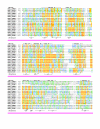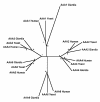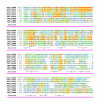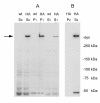Expression and genomic analysis of midasin, a novel and highly conserved AAA protein distantly related to dynein
- PMID: 12102729
- PMCID: PMC117441
- DOI: 10.1186/1471-2164-3-18
Expression and genomic analysis of midasin, a novel and highly conserved AAA protein distantly related to dynein
Abstract
Background: The largest open reading frame in the Saccharomyces genome encodes midasin (MDN1p, YLR106p), an AAA ATPase of 560 kDa that is essential for cell viability. Orthologs of midasin have been identified in the genome projects for Drosophila, Arabidopsis, and Schizosaccharomyces pombe.
Results: Midasin is present as a single-copy gene encoding a well-conserved protein of approximately 600 kDa in all eukaryotes for which data are available. In humans, the gene maps to 6q15 and encodes a predicted protein of 5596 residues (632 kDa). Sequence alignments of midasin from humans, yeast, Giardia and Encephalitozoon indicate that its domain structure comprises an N-terminal domain (35 kDa), followed by an AAA domain containing six tandem AAA protomers (approximately 30 kDa each), a linker domain (260 kDa), an acidic domain (approximately 70 kDa) containing 35-40% aspartate and glutamate, and a carboxy-terminal M-domain (30 kDa) that possesses MIDAS sequence motifs and is homologous to the I-domain of integrins. Expression of hemagglutamin-tagged midasin in yeast demonstrates a polypeptide of the anticipated size that is localized principally in the nucleus.
Conclusions: The highly conserved structure of midasin in eukaryotes, taken in conjunction with its nuclear localization in yeast, suggests that midasin may function as a nuclear chaperone and be involved in the assembly/disassembly of macromolecular complexes in the nucleus. The AAA domain of midasin is evolutionarily related to that of dynein, but it appears to lack a microtubule-binding site.
Figures










Similar articles
-
Structural Insights into Mdn1, an Essential AAA Protein Required for Ribosome Biogenesis.Cell. 2018 Oct 18;175(3):822-834.e18. doi: 10.1016/j.cell.2018.09.015. Epub 2018 Oct 11. Cell. 2018. PMID: 30318141 Free PMC article.
-
The Crystal Structure of the Ubiquitin-like Domain of Ribosome Assembly Factor Ytm1 and Characterization of Its Interaction with the AAA-ATPase Midasin.J Biol Chem. 2016 Jan 8;291(2):882-93. doi: 10.1074/jbc.M115.693259. Epub 2015 Nov 24. J Biol Chem. 2016. PMID: 26601951 Free PMC article.
-
Long-range intramolecular allostery and regulation in the dynein-like AAA protein Mdn1.Proc Natl Acad Sci U S A. 2020 Aug 4;117(31):18459-18469. doi: 10.1073/pnas.2002792117. Epub 2020 Jul 21. Proc Natl Acad Sci U S A. 2020. PMID: 32694211 Free PMC article.
-
Model for the motor component of dynein heavy chain based on homology to the AAA family of oligomeric ATPases.Structure. 2001 Feb 7;9(2):93-103. doi: 10.1016/s0969-2126(00)00557-8. Structure. 2001. PMID: 11250194
-
Using chemical inhibitors to probe AAA protein conformational dynamics and cellular functions.Curr Opin Chem Biol. 2019 Jun;50:45-54. doi: 10.1016/j.cbpa.2019.02.019. Epub 2019 Mar 23. Curr Opin Chem Biol. 2019. PMID: 30913482 Free PMC article. Review.
Cited by
-
Origin of the cell nucleus, mitosis and sex: roles of intracellular coevolution.Biol Direct. 2010 Feb 4;5:7. doi: 10.1186/1745-6150-5-7. Biol Direct. 2010. PMID: 20132544 Free PMC article.
-
Structural Insights into Mdn1, an Essential AAA Protein Required for Ribosome Biogenesis.Cell. 2018 Oct 18;175(3):822-834.e18. doi: 10.1016/j.cell.2018.09.015. Epub 2018 Oct 11. Cell. 2018. PMID: 30318141 Free PMC article.
-
Whole-Genome Sequencing and Annotation of the Yeast Clavispora santaluciae Reveals Important Insights about Its Adaptation to the Vineyard Environment.J Fungi (Basel). 2022 Jan 5;8(1):52. doi: 10.3390/jof8010052. J Fungi (Basel). 2022. PMID: 35049992 Free PMC article.
-
The Crystal Structure of the Ubiquitin-like Domain of Ribosome Assembly Factor Ytm1 and Characterization of Its Interaction with the AAA-ATPase Midasin.J Biol Chem. 2016 Jan 8;291(2):882-93. doi: 10.1074/jbc.M115.693259. Epub 2015 Nov 24. J Biol Chem. 2016. PMID: 26601951 Free PMC article.
-
Maize reas1 Mutant Stimulates Ribosome Use Efficiency and Triggers Distinct Transcriptional and Translational Responses.Plant Physiol. 2016 Feb;170(2):971-88. doi: 10.1104/pp.15.01722. Epub 2015 Dec 8. Plant Physiol. 2016. PMID: 26645456 Free PMC article.
References
-
- Bassler J. et al.Identification of a 60S preribosomal particle that is closely linked to nuclear export. Mol Cell. 2001;3:517–529. - PubMed
-
- Neuwald AF, Aravind L, Spouge JL, Koonin EV. AAA+: A class of chaperone-like ATPases associated with the assembly, operation, and disassembly of protein complexes. Genome Res. 1999;3:27–43. - PubMed
LinkOut - more resources
Full Text Sources
Other Literature Sources
Molecular Biology Databases

